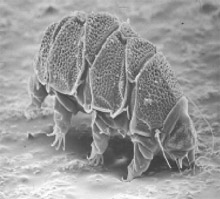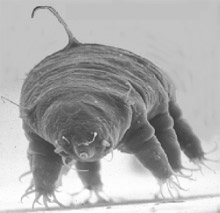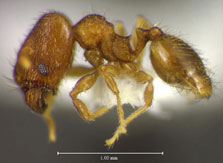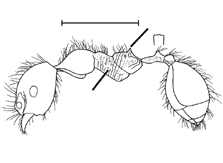April 30, 2004
Air Date: April 30, 2004
FULL SHOW
SEGMENTS
A Little Known Planet, Part 1
/ Diane ToomeyView the page for this story
It may be surprising to learn that we really have no idea how many species exist on our planet. Many experts believe that the earth plays host to anywhere from 10 to 30 million species. A few say that number could be much higher. But by any reckoning, only a fraction of them are known to science. On this special edition of Living on Earth, Science Editor Diane Toomey visits with famed biologist E.O. Wilson. He’s calling for an all-out effort to discover, describe and classify as many of them as they can before it’s too late. (13:00)
A Little Known Planet, Part 2
/ Diane ToomeyView the page for this story
Nine years ago, the National Science Foundation launched a grant program to help pull the basic science of species identification out of the scientific backwaters. The initiative funds graduate students in particularly hard hit fields of taxonomy. Living on Earth’s Diane Toomey tagged along with one such student and her professor. (19:00)
A Little Known Planet, Part 3
/ Diane ToomeyView the page for this story
We've heard how both researchers and the lay public can help count up the earth's creatures. Now, in the final segment of Living on Earth’s special, we'll see how technology is helping to speed up the identification of species. But first, we’ll see how things were done the old fashioned way. And for that, Living on Earth's Diane Toomey returns us to famed Harvard biologist E.O. Wilson. (16:30)
Show Credits and Funders
Show Transcript
HOST: Steve CurwoodREPORTER: Diane Toomey
CURWOOD: From NPR, this is Living on Earth.
[THEME MUSIC]
CURWOOD: I'm Steve Curwood. How many species make their home on planet Earth? The answer is, we don’t know. Few life forms here have actually been described by science. Now scientists are calling for an all out effort to survey life on earth. Biologist E. O Wilson says there’s one good reason to do this inventory.
WILSON: Obviously in the realm of conservation we can’t save what we don’t know.
CURWOOD: Already some amazing creatures are being found under the microscope. One of these is called the water bear.
SPIEGEL: You watch for a bit and you start to see how it moves and it moves in a very mammalian like pattern. It kind of moves it’s head from side to side and it waves it’s arms around. That’s why I call it the charismatic microfauna.
CURWOOD: We take a journey to a little known planet on Living on Earth, right after this.
FEMALE ANNOUNCER: Support for Living on Earth comes from the World Media Foundation and Stonyfield Farms.
A Little Known Planet, Part 1
CURWOOD: From the Jennifer and Ted Stanley studios, this is Living on Earth. I’m Steve Curwood.
Recently, Japanese researchers surprised the world when they published a paper describing a new species of whale. They say they discovered this baleen whale when they were studying the DNA of the 36 foot long Byrde’s whale, which swims off the coast of Japan. A new species this size is a rare find these days, but in fact we really have no idea how many species exist on our planet. Many experts believe that the Earth plays host to anywhere from 10 to 30 million distinct forms of life. A few say that number could be as high as 100 million. But less than two million life forms have been given a formal name and studied in at least some minimal way. And as species disappear at an unprecedented rate, scientist hope to discover, describe and classify as many of them as they can before it’s too late.
On this special edition of Living on Earth, Science Editor Diane Toomey will chronicle the who and how of this massive endeavor: the cutting-edge technologies, and the labor, both scientists and non scientists alike, that will be needed. And we’ll hear from the grand old man of biodiversity himself, E.O. Wilson.
So let’s set off to explore this little known planet.
[CROWD NOISE]
TOOMEY: It's a pleasant autumn night on New York's upper east side. Inside the elegant explorer's club, jut off Park Avenue, scientists are gathering to honor a group of colleagues. I make my way past the stained glass windows, up the staircase lined with wood-paneled walls, turn right at the stuffed polar bear, and find the library room, where dozens have assembled. The club was founded almost a century ago by a band of gentleman-adventurers. And the photos of such legendary members as Ernest Shackleton, Lowell Thomas, and Sir Edmund Hillary hang from the walls. All were inspired, as club literature reads, by the desire to pry from the earth its long-held secrets. The same is true for tonight's honorees. But for them, it's not about big game or big mountains. For instance there's Fred Speigel, a University of Arkansas biologist. He's launching a worldwide hunt for all the species of slime mold.
SPIEGEL: Slime molds are rather unfortunately named. But they're called slime molds because the feeding stage is protozoa-like. It’s an amoeba. So that's the slime part. The mold part is they form these absolutely spectacular fruiting bodies that look like little fungi, mushroom like organisms. And they're jewels. My father-in-law stopped considering me a bum when he saw how beautiful they are.
TOOMEY: Fred Spiegel is one of four researchers leading what are known as planetary biodiversity inventories. It's a new strategy, funded by the National Science and All Species foundations, to discover the unknown life on Earth. As the National Science Foundation puts it, our generation is the first to be aware of mass extinctions now occurring and the last to have the chance to inventory much of our planet's biodiversity before it disappears. So over the next five years, international teams will venture into the field, labor in the lab and scour the backrooms of museums, worldwide, in search of all the species in their particular specialty. A team will focus on catfish, another on a family of plant-feeding insects known as miridae, and there's even a botanist being feted here tonight.
BOHS: My name is Lynn Bohs and my specialty is the plant genus solinum. This genus includes tomato, potato and eggplant, a lot of other species that are used as food crops and also plants that are used as medicinal compounds.
TOOMEY: The University of Utah researcher says being part of a planetary biodiversity inventory, or PBI, is daunting.
BOHS: It's scary but exciting. This is a dream for us. Three of us were in the field in South America together a couple of years ago and talked about doing this project before we even knew about the PBI program. So as soon as we saw the announcement we said we’ve got to go for it.
TOOMEY: There was a time when this kind of basic exploration was the very backbone of the biological sciences. But it fell out of favor in the last century.
[LOW TALKING]
TOOMEY: Now, a number of influential researchers are calling for a return to basic exploration – everywhere, for everything.
WILSON: Now what I'm going to do is take a specimen from one of scores of cabinets just for the genus pheidole alone, in the insect collections here in the Museum of Comparative Zoology.
 E.O. Wilson looks at an ant nest in the Dominican Republic. (Photo: Brian Farrell) |
TOOMEY: E.O. Wilson leans over a large wooden box, filled with dozens of specimens of the creature that's made him famous – ants. The preeminent biologist's accomplishments include pioneering work on the chemical communication of ants and in the field of sociobiology. He's famous to non-scientists through his Pulitzer-prize winning books.
Nowadays, he's perhaps best known as a spokesperson for conservation. Wilson even coined the terms biodiversity and biophilia. But today, in his Harvard office, we’re talking ants. He carefully picks up one of the tiny insects and places it under his microscope. WILSON: Now I'm going to sit down, and get the specimen under the scope so it can be viewed properly, and get the magnification down first so we can locate the specimen and line it up in the correct position. TOOMEY: Before he leans towards the microscope, Professor Wilson flips back a lock of his hair. And in that moment, and despite the fact he's dressed in professorial tweed, the expectant look of a boy comes over his face. WILSON: Caltrop! And this one is called caltrop because it has long needlelike spines on the back of the middle part of its body and it made me think of a caltrop. You know this triangular spine weapon that used to be thrown on the ground in ancient warfare. TOOMEY: At 74, Professor Wilson's enthusiasm for his ants remains unabated. But these days, it's the life that remains unknown that plays more and more on his mind. WILSON: It’s not an exaggeration to say we live on a little known planet. And the science of biology in the 21st century will depend on a closer examination of the diversity of life at the species level and an all out effort to complete the mapping of life on Earth. TOOMEY: That's what Wilson and others are calling for - a concerted effort over the next quarter century to discover and describe the millions of species that remain unknown to formal science. While creatures like birds, mammals, and flowering plants are relatively well known, it’s the smallest life forms – things like nematodes, millipedes, and bacteria – that largely remain a mystery. Wilson calls these unheralded organisms the little creatures that run the world. And he says there's a price to pay if we ignore of them. WILSON: When biologists go forth into the field, to understand how ecosystems work, to identify new invasive species, to identify the pathogens of new diseases, to look for new pharmaceuticals among plants and even insects, the typical experience is they can’t identify large numbers of these species. They’re not even aware of their existence. TOOMEY: For instance, before they were discovered in the 1970s, who imagined that microorganisms – known as extremophiles – could survive in the boiling temperatures of ocean thermal vents or in icy polar seas or in acidic hot springs. Research on one such bizzare creature led to the development of a technique called polymerase chain reaction, now a common and indispensable method of duplicating DNA. The enzyme of another is now used to make a protein-degrading additive for detergents. Other extremophiles are being mined for possible sources of new antimicrobial agents. But E.O. Wilson says there's another, more basic reason behind the need for a global survey. WILSON: Obviously, in the realm of conservation, we can’t save what we don’t know. TOOMEY: And the key to carrying out this survey is the discipline known as taxonomy. That's the science of discovering, describing and classifying species. But there's a glitch. Taxonomy fell out of favor in the last century, as microbiology took center stage – and most of the research money. Now, there are few scientists who have the ability to discern the often maddeningly subtle, minute details that differentiate one species from another. Dr. Wilson never left the basic work of ant identification. In fact, he's recently published an 800-page opus on just one genus of ant – pheidole – otherwise known as the big-headed ants. WILSON: Their heads are filled with adductor massive muscles. They're the Schwarzenegger only from the chest up. And those powerful sharp jaws they have allows them to operate like wire clippers when they meet enemies. They just chop off their legs and heads and so on. Along with them you'll see the skinny little minor workers that do all the work. TOOMEY: And get none of the credit? WILSON: Well, they get if from me! 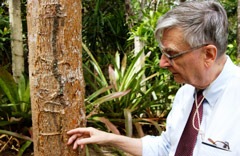 E.O. Wilson points to a termite trail on a tree in the Dominican Republic. (Photo: Brian Farrell) WILSON: It was done for the love of the ant itself, for the love of work itself. Just as a loving exercise in natural history. TOOMEY: Wilson's love of natural history has its origins in his boyhood. He says he never outgrew his bug stage. But he did have a mentor in his study of ants. WILSON: When I was 18 years old, I announced while I was an undergraduate at University of Alabama, that my great ambition was to do a complete study of the ants of Alabama. Well, you've got to start somewhere. And this young graduate student, just seven years older than me, was at Harvard. And he heard about me and we started corresponding. And he said, look Wilson, the ants of Alabama isn't going to cut it. What you've got to do is get a broader perspective and start working on the basic biology of a group of ants and look abroad and get moving. TOOMEY: Dr. Wilson says entomologist Bill Brown took him under his wing, introduced him to researchers at Harvard and, as Wilson puts it, he never looked back. In his latest book, Wilson includes a tribute to his mentor. WILSON: He welcomed you. He treated you with respect. He stood in awe with you before the intricacy of the subject. He gladly taught and learned. He created a sense that here in this little discipline was something – to borrow from F. Scott Fitzgerald - the kind of writer Bill Brown so admired – something commensurate to man's capacity for wonder. In 1950, he was 28 and I was 21, and the whole world seemed ours to possess. TOOMEY: Everyone should have such a mentor. WILSON: I would like to provide that lesson for everyone if I possibly could. TOOMEY: Taxonomy is going to need many more mentors if the millions of unknown species are ever to be identified. But, right now, many creatures have no experts. For instance, the last camel cricket specialist died in 1989. Want to study the grasshoppers of the Caucasus and need help? Well, you’re about three decades too late. The endangered status of taxonomists has even led to jokes. One goes like this – taxonomists are so rare, maybe they should all be brought in from the wild and enrolled in a captive breeding program. [MUSIC] CURWOOD: You’re listening to “A Little Known Planet.” Coming up: Diane Toomey takes us to visit a program to encourage students to take up the basic science of classifying forms of life. You’re listening to NPR’s Living on Earth.
A Little Known Planet, Part 2CURWOOD: Welcome back to Living on Earth’s special “A Little Known Planet.” I'm Steve Curwood. It's probably easy to find a lot of 4th graders who say they'd like to study chimpanzees or whales or elephants when they grow up. But what 4th grader goes around saying I want to be a sea slug taxonomist? But sea slugs, along with parasitic wasps, bark beetles and many other organisms, are among the many understudied creatures that make up a critical part of ecosystems. In 1994, the National Science Foundation launched a grant program to help pull the basic science of species identification out of the scientific backwaters. The initiative funds graduate students in particularly hard hit fields of taxonomy. Living on Earth’s Diane Toomey visited with one such student and her professor. SIDDAL: Now talk to me. What's going to be convenient for you guys out there? Buckets? BORDA: Tubes. [TUBES CLINKING TOGETHER] TOOMEY: Researcher Mark Siddall stands on the shore of a small pond on the campus of the University of Connecticut in Storrs, handing out equipment to his assistants. SIDDALL: These are 50mL falcon tubes normally used for centrifuging various compounds. We of course use them for collecting leeches. TOOMEY: Blood- sucking leeches are the focus of much of Mark Siddall's work. He's a curator at the American Museum of Natural History in New York City. While most people might go out of their way to avoid leeches, he goes out of his to find them. Siddall has looked for them from the jungles of Madagascar to the mountains of the Andes. Today, he's searching in western Connecticut. And after making sure her waders are properly secured, he sends his 27 year-old his graduate student, Liz Borda, into the chilly waters. [WATER SLOSHING] SIDDALL: All right kids. Get outta here! BORDA: Alright. SIDDALL: Go out and find some leeches! BORDA: Yes, Pappa Leech. [SOUNDS OF WADING, SPLASHING] TOOMEY: Now that we’re out here, describe what happens next. BORDA: So, we're just gonna stand around here, move our legs, shake our legs, hopefully not fall in. They'll be attracted to movement, so they’ll come swimming towards us. So we'll just stand around and wait. [WATER SLOSHING] TOOMEY: The mission today - find the New England medicinal leech, which hasn't been seen since the 1970s. The word medicinal is a leftover from blood–letting days. And although leech anticoagulants are put to use in modern medicine, during procedures such as limb attachments, that’s not why this team is interested in them. They’re motivated by simple scientific curiosity. They want to find out if the New England medicinal leech is really a distinct species and if it’s gone extinct.  Liz Borda searches for leeches in Madagascar. (Photo: Mark Siddall) [WATER SLOSHING] TOOMEY: Liz brings the tiny, brown creature wriggling on the palm of her hand to Dr. Siddall to identify. SIDDALL: Helibdelastagnalis. It might be surprising that with a naked eye I can identify a species of leech that’s maybe 4 millimeters long. TOOMEY: I'm impressed. SIDDALL: But if you look carefully in the light there's a tiny black dot on the neck, well, not really a neck, and that's the only species in North America that has that. TOOMEY: Mark Siddall is one of only a handful of leech taxonomists in the world. He’s obviously devoted to the study of his creature – he even keeps a Leech Man action figure on display in his office. That's why he wants to pass on his knowledge and, as he puts it, replace himself. But his is an uphill battle. SIDDALL: I have trouble getting scientists excited about leech systematics. I mean, let’s be honest. If you put me in a room next to Ed Wilson, who works on ants, people get excited about ants. But leeches, it’s like oooooh. TOOMEY: And that was Liz Borda's reaction when she first encountered leeches on a trip to Madagascar to study lemurs. One day, while she was out on a hike… 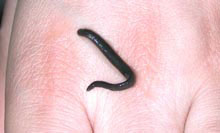 Freshwater leech of Madagascar. (Photo: Mark Siddall) TOOMEY: But somehow, when she interviewed for a job as an assistant in Siddall's lab, she resisted the urge to run out the door when he told her what he did for a living. But because of the chance to participate in his field work, Liz says she eventually decided to follow in Dr. Siddall’s footsteps. BORDA: Ok, maybe it’s not the cute and fuzzy animals I wanted to study but maybe this could be something different. TOOMEY: And for the brave few like Liz, there’s a lot more leeches to find. For instance, Mark Siddall says in one six-week trip to Madagascar, he doubled the known number of terrestrial leech species on that island. [WATER SPLASHING AND BIRDS CAWING] TOOMEY: But no such luck today. The team has struck out at another pond, this one in nearby Massachusetts. SIDDALL: This is a sad day. This has been the third time I’ve been here, looking for this leech, but I can't keep justifying coming back to same place. TOOMEY: Why do you care about finding this guy, the New England medicinal leech? SIDDALL: Oh, wow. I guess my first answer would be somewhat flippant. Why not? Academically speaking, it would be interesting to know if this species is a valid species, and that would lead us to try and understand why it’s why it's so rare. As far as understanding something that would be of benefit to humanity, that's really not my concern. I'm not bothered by that. But then neither was the person who first described the giant Amazonian leech, in the 1800s I think or the early 1900s. Nobody cared. But now we know that species has an incredibly powerful anti-coagulant that will actively break down clots after they’ve formed. Now, if no one had bothered to give that species a name and identify where it occurs and where it lives, would have bothered to look for it later to see if it had some of these properties? So my job is on the descriptive side of things. What's out there? Where are they? How are they related? I'll leave it for someone more qualified than me to figure out why that might be interesting. [WATER SLOSHING, BIRD CAWING] TOOMEY: Mark Siddall looks down into the chilly water, and as he continues, I hear the passion in his voice. SIDDALL: You know, the world would be a darker, more lonely place without them. If all we had were antelope, and elephants, and panda bears, the world would be a pretty boring place. The fullness of biodiversity itself is something that's aesthetically beautiful. [WATER SLOSHING, BIRD CAWING] TOOMEY: Liz Borda says when she finishes her PhD in a few years, she hopes a museum, or the like, will want to employ a leech taxonomist. In the meantime, just studying leeches has its benefits. BORDA: Honestly, saying you work on leeches can either be a conversation starter or conversation stopper. So you can use it to your advantage at times I think. [LAUGHTER] TOOMEY: It kind of weeds out the men from the boys? BORDA: Exactly [LAUGHS]. TOOMEY: If Liz ever discovers a new leech species, scientific protocol dictates she’ll get the honor of naming it. That’s something E.O. Wilson has had plenty of experience doing. Just for this latest book, he had to come up with more than three hundred names for the new species of pheidole ants he discovered. They include Pheidole harlequina, named for it's multicolored body, Pheidole harrisonfordi, named in honor of the actor, for his support of conservation causes, and Pheidole bison, alluding to the massive humped back of that species’ soldier ant. After studying this group for almost two decades, I asked Dr. Wilson if he had any favorites. He tells me about a rare species that has a rather unusual way of protecting its nests. WILSON: They have heads shaped like the cork of a wine bottle and the front of the head is heavily armored like an old Greek shield. And what they do when enemies appear is they then plug the nest with their heads. And I think, to use the current word, that's kind of cool. TOOMEY: And cool, Dr. Wilson says, will help to lure people to the study of the natural world. And if that deadline of finding all the unknown species in 25 years is to be met, people without scientific training will also need to get involved. There's one place in the U.S. where so-called citizen scientists are already being put to the test. [CROWD NOISE, COUNTRY MUSIC] TOOMEY: The visitor’s center at the Great Smokey Mountains National Park is hopping today. In the autumn, tourists come to this park, which straddles the border between North Carolina and Tennessee, to take in stunning foliage. And then they hit the gift shop for post cards, patches, and pumpkin butter. [CROWD NOISE, COUNTRY MUSIC] MALE: Thank you. Have a good day. TOOMEY: But just a few short miles from this racket, two citizen scientists labor in quiet determination. 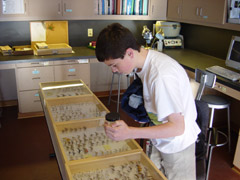 Alex Cassella identifies moths at a research facility in the Great Smokey Mountains National Park. (Photo: Jonathan Mays) P.CASSELLA: You need an opinion? A. CASSELLA: Is that possible? Do we possibly have him? P. CASSELLA: I think, maybe. A. CASSELLA: Could it be a color variation? Or is it…. TOOMEY: 14-year-old Alex Cassella and his mother Paige are combing field guides at a research facility in the park. With the help of park ranger Jonathan Mays, they’re comparing pictures of brown moths to the actual brown moth in front of them. MAYS: He has a margin on the rear of its forewing. Let’s check in the Quebec book. A. CASSELLA: God, the one that’s all in French? TOOMEY: Twice a month, Alex and his mom come to the park to empty a moth trap, a Rube Goldberg contraption that uses a black light to lure the moths into a refrigerator. And then they try to figure out what's been caught. Alex, a teenager with a mature demeanor and a direct gaze, is home-schooled. But here in the Smokies, he studies under the guidance of park employees. And he’s gotten to the point where he can identify a number of moths down to the species level. A. CASSELLA: Well, you can tell by the wing shape here, how his wings are folded back here that he’s a noctuid. You can see he has a pattern that’s very distinct. He’s got a light spot here, then a dark spot with a tiny spot of pure white in it. Like a reverse eye. TOOMEY: In his small way, Alex is helping to complete a large project – the All Taxa Biodiversity Inventory. That's the name of the park's five year old effort to find and identify every life form within its half-million acres – bears to bacteria. It's the first project of its kind in the U.S. The mission has already discovered more than four hundred species, including beetles, millipedes, fungi, crayfish and slime molds. Alex hasn't found any new moth species – yet – but says he’s glad to help out and he’s learned a lot. A. CASSELLA: I didn’t think there’d be nearly as many moths as there were - nondescript LBMs – little brown moths. TOOMEY: The survey has a shoestring budget, supported mostly by two non-profit organizations. So in the summer months, armies of volunteers descend on the Smokies for activities with names like fern foray and beetle blitz. Keith Langdon is the supervisory biologist at the park and coordinates the inventory. He says the involvement of citizen scientists is essential, but it's risky. LANGDON: What we found out hard way is that you can’t invite citizens in and turn ‘em loose, because they need someone to show ‘em the ropes. And when you’re talking about data, that bad data is far worse then no data at all. And so it requires some supervision, some structure. So we’ve been careful to expand the volunteers to where we can provide the data to make it trustworthy. TOOMEY: So the park has a mandatory training program to insure that specimens sent to experts for identification have accurate where and what information attached to them. Langdon says many volunteers participate once. Some are repeat citizen scientists. Only a few are hardcore. LANGDON: The gold standard here is to find someone who just becomes enamored, almost obsessed with a particular group, and actually do become local regional experts. But it’s difficult to find people who have the time and the wherewithal to provide that. TOOMEY: And there are bottlenecks. There’s only so many staff members to train and supervise volunteers. And while it may be relatively easy to get people out on the trails to collect the bottles of bugs caught in traps, that's just the beginning. LANGDON: We need people to go through and sort the moths from the beetles from the flies from the ants. That’s a real bottleneck. The world authorities don’t have time to do that. TOOMEY: Langdon says he can’t really blame citizen scientists for having their limits. LANGDON: Let’s face it. When you come to a national park, you want to hike, you want to get out and see some of the wildlife and see some vistas. [TREES RUSTLING, BIRDS CALLING] BARTLES: This is the minus 70 degree freezer which we use for all kinds of samples. The top shelf of that is crammed with samples from the Smokies. TOOMEY: Right now, the only vista that concerns zoologist Paul Bartles is the one he sees in his lab freezer. BARTLES: We've done most of the field collecting and we have a huge backlog of doing the lab processing. It takes something like six hours of lab work for every hour in field to process that stuff. TOOMEY: That stuff is the hundreds of baggies crammed into this freezer that are stuffed with moss, lichen or soil, which are, in turn, chuck full of tardigrades. Never heard of a tardigrade? Well, neither had I. BARTLES: There's something crawling around. Let's see what that is. Ah. Right there. There is a tardigrade. TOOMEY: Dr. Bartles, a professor at Warren Wilson College in Asheville, North Carolina, zeroes in on one of these microscopic creatures and then let's me have a look.
|

